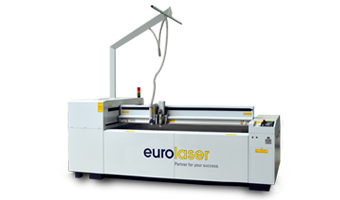Further CO2 laser cutter for the processing of PMMA (PLEXIGLAS®)

High-quality injection moulded parts are subjected to the highest demands and are viewed critically by the end consumer. Examples of their use include displays for mobile phones, in TV and hi-fi equipment ("brown goods"), vehicle instrumentation, and as display and control panels for washing machines, dishwashers and dryers ("white goods"). Buyers of semi-finished injection-moulded products demand goods of the highest quality with flawless and resilient surface finish. The established methods of injection moulding in themselves are not a bottleneck. However, the sprue must be removed retrospectively without damaging the material and surface structure in order to complete and prepare the component for further manufacturing steps such as tempering, inscription by screen printing, etc.
The preferred forming process for mass production is injection moulding. Even moulded parts such as acrylic panels are pressed in moulds by means of injection moulding. The remaining sprue must be removed in a separate process. It is not usually clean enough to simply break off the sprue. If the remains are removed by machine, this always results in particles which stick to the workpiece due to the static charge, and make further processing more difficult or even prevent it altogether. This necessitates rework, which in turn is associated with costs. Laser cutting is the ideal solution for this, and it is possible for the whole process to be fully automated.


In collaboration with a large processor of plastics, eurolaser has developed an individual customer solution, in which the laser system has been incorporated into an existing production line. Materials are fed in and removed fully automatically under the control of robots. The laser system is matched to the upstream and downstream unit by means of open interfaces. The workpieces are presented in an unloading magazine, the gripper arm removes them and feeds them to the laser on a conveyor belt. The laser cuts off the sprue. The vaporised material and the sprue are picked up by the extraction pipe underneath and the exhaust air is filtered. The cut panels are fed via the conveyor belt to the unloading and packaging unit and are immediately ready for further processing. During the removal process, the cut edge remains perfectly transparent and does not have to be labour-intensively repolished, as is necessary with conventional mechanical processes.
For further information please click the links below:
The advantages to you in summary:
- Polished cut edges without rework
- Both extruded and cast PMMA can be processed
- Chipless removal of remaining sprue
- No tool wear and no tool changes required in contrast to sawing, milling or drilling
- No clamping or fixing required when cutting acrylic glass
- High repeat accuracy and consistent quality
Do you have any questions? We are pleased to advise you.




